
Goombungee War Memorial is a heritage-listed memorial at Hartwig Street, Goombungee, Toowoomba Region, Queensland, Australia. It was built in 1920 by R C Ziegler and Son. The architect was Harry Marks. It was added to the Queensland Heritage Register on 21 October 1992.
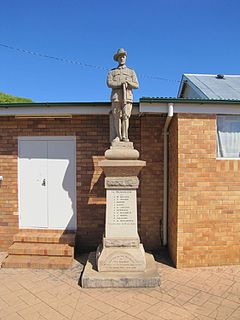
Westbrook War Memorial is a heritage-listed memorial at 114 Toowoomba Road, Westbrook, Toowoomba Region, Queensland, Australia. It was constructed in 1922 by Toowoomba masonry firm Bruce Brothers, and lies adjacent to the Westbrook Public Hall, which it predates. It stands 4.2 metres (14 ft) high, and consists of a statue of a digger atop a sandstone pedestal and base. The memorial contains the names of the 10 local men who died during World War I on the front face, and the 37 who served on the side faces. It was added to the Queensland Heritage Register on 21 October 1992.

Weeping Mother Memorial is a heritage-listed memorial at Hickey Street, Gatton, Queensland, Australia. It was designed by F. Williams & Co and built in 1922 by the same company. The memorial was added to the Queensland Heritage Register on 21 October 1992.
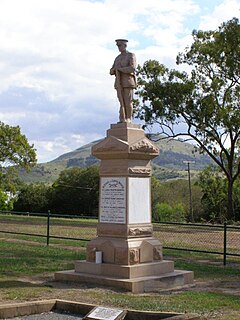
Ma Ma Creek War Memorial is a heritage-listed memorial on the Gatton-Clifton Road, Ma Ma Creek, Queensland, Australia. It was completed in 1920. It was added to the Queensland Heritage Register on 21 October 1992.

Beaudesert War Memorial is a heritage-listed memorial at William Street, Beaudesert, Queensland, Australia. It was built from 1919 to 1921. It was added to the Queensland Heritage Register on 21 October 1992.
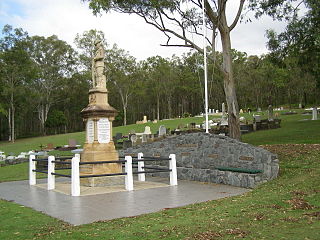
Pimpama & Ormeau War Memorial is a heritage-listed memorial at Pacific Highway, Pimpama, Queensland, Australia. It was built in 1919. It was added to the Queensland Heritage Register on 21 October 1992.
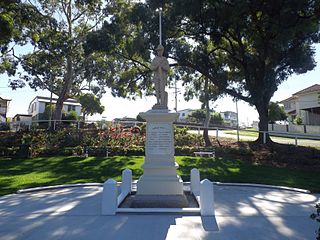
Manly War Memorial is a heritage-listed memorial at 184 Carlton Terrace, Manly, City of Brisbane, Queensland, Australia. It was built from 1920 to 1921. It is also known as Ferguson Street Reserve, Manly Dam, and Soldiers Memorial Park. It was added to the Queensland Heritage Register on 21 August 1992.
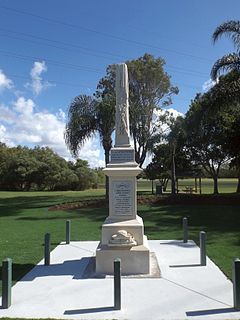
Anning Monument is a heritage-listed memorial at the corner of Hemmant and Tingalpa Road and Boonoo Street, Hemmant, City of Brisbane, Queensland, Australia. It was designed and built by William Busby in 1903. It is also known as Hemmant Boer War Memorial. It was added to the Queensland Heritage Register on 21 October 1992.

Charleville War Memorial is a heritage-listed war memorial at Edward Street, Charleville, Shire of Murweh, Queensland, Australia. It was designed by George Brockwell Gill and built in 1924 by R C Ziegler and Son. It was added to the Queensland Heritage Register on 21 October 1992.

Ipswich Railway Workshops War Memorial is a heritage-listed memorial at the North Ipswich Railway Workshops, North Street, North Ipswich, City of Ipswich, Queensland, Australia. It was designed by Vincent Price and built in 1919. It was added to the Queensland Heritage Register on 21 October 1992.

Goomeri War Memorial Clock is a heritage-listed memorial at Burnett Highway, Goomeri, Gympie Region, Queensland, Australia. It was built in 1940. It was added to the Queensland Heritage Register on 21 October 1992.

Brooweena War Memorial is a heritage-listed memorial at Smith Crescent, Brooweena, Fraser Coast Region, Queensland, Australia. It was built in 1922 by F W Webb. It was added to the Queensland Heritage Register on 21 October 1992.

War Memorial Bridge is a heritage-listed memorial bridge at Brooweena-Woolooga Road, Brooweena, Fraser Coast Region, Queensland, Australia. It was designed by Lawrence Stevens Smith and built in 1921 by Frederick William Webb. It was added to the Queensland Heritage Register on 21 October 1992.

Howard War Memorial is a heritage-listed memorial at William Street, Howard, Fraser Coast Region, Queensland, Australia. It was built in 1921. It was added to the Queensland Heritage Register on 21 October 1992.
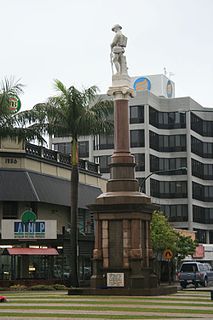
Bundaberg War Memorial is a heritage-listed memorial at Bourbong Street, Bundaberg Central, Bundaberg, Bundaberg Region, Queensland, Australia. It was designed by Frederic Herbert Faircloth and built from 1920 to 1921 by Anselm & Odling (Sydney). It was added to the Queensland Heritage Register on 21 October 1992.

Finch Hatton War Memorial is a heritage-listed memorial at Anzac Parade, Finch Hatton, Mackay Region, Queensland, Australia. It was designed by Melrose & Fenwick and built in 1921 by Melrose & Fenwick. It was added to the Queensland Heritage Register on 21 October 1992.

War memorials were erected in many towns of Queensland, Australia, in commemoration of the service and death of many Queenslanders in World War I.

Barcaldine War Memorial Clock is a heritage-listed memorial at Ash Street, Barcaldine, Barcaldine Region, Queensland, Australia. It was designed and built in 1924 by monumental masons Andrew Lang Petrie and Son. It was added to the Queensland Heritage Register on 21 October 1992.
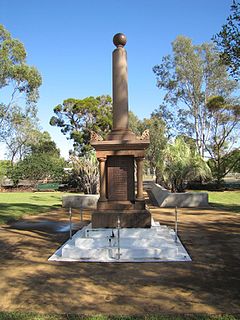
Mitchell War Memorial is a heritage-listed memorial at Cambridge Street, Mitchell, Maranoa Region, Queensland, Australia. It was designed and built in 1927 by Andrew Lang Petrie and Son. It was added to the Queensland Heritage Register on 21 October 1992.

War Memorial and Heroes Avenue is a heritage-listed memorial at Bungil Street, Roma, Maranoa Region, Queensland, Australia. It was built in 1920. It was added to the Queensland Heritage Register on 21 October 1992.





















